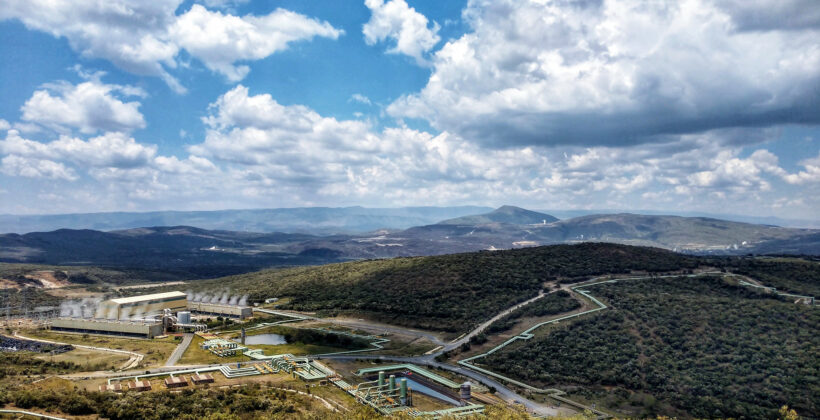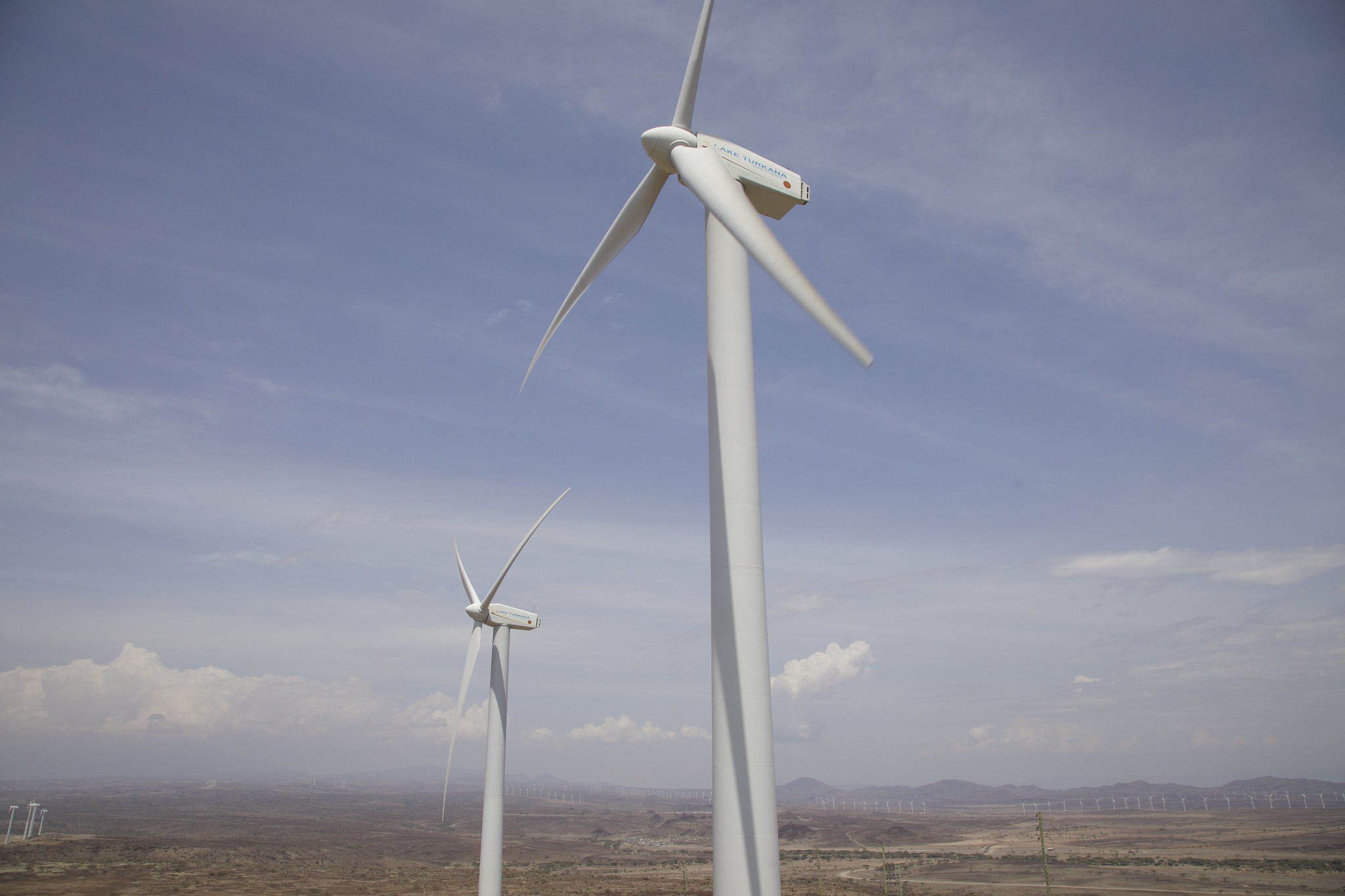
When William Ruto was sworn in as Kenya’s fifth president in September 2022, he used his inauguration speech to demand an end to humanity’s “addiction to fossil fuels” and reaffirmed Kenya’s commitment to reach 100% clean energy by 2030. Kenya is not far off this target today.
In 2021, 81% of Kenya’s electricity generation came from the low carbon sources of geothermal, hydro, wind, and solar power. Over half of this low carbon electricity came from geothermal energy, which Kenya has in abundance. So much in fact, that excess geothermal energy is released during the night when electricity demand is low. Installed geothermal capacity in Kenya could be increased by at least eightfold, which could open opportunities for scaling up green manufacturing capacity or exporting excess electricity to neighbouring countries.
Renewable rollouts have substantially improved energy access. In 2013, around 28% of Kenyans had access to electricity. By 2020, this had risen to over 71%. This was achieved as the population grew by over seven million over the same period, while the rate of urbanisation continued to gather pace. According to the World Bank, barely one million Kenyans had electricity in 1990.

Ruto’s words, and Kenya’s actions, are timely due to the backdrop they are made against. Amid Russia’s invasion of Ukraine, and the vacuum created in global energy markets, European leaders and multinational fossil fuel firms have launched a ‘dash for gas’ across Africa, where a raft of new oil and gas projects, as well as old ones, are being given the green light. At COP27, Ruto kicked back against the dash for gas, stating that “we [Kenya] have taken a position that as a country we are going green and we are well on course”.
If these fossil fuel projects go ahead, they will lock Africa into a high-carbon, high-cost, and high-pollution energy system that will wreak havoc on communities, natural systems (the long known ‘resource curse’), and the climate. Given what’s at stake, both for Africa and the rest of humanity, exploring Kenya’s ascendancy to a clean energy superpower is vital.
Scaling up renewable energy generation across Africa is vital for achieving sustainable development and bringing health, wealth, and opportunity to the citizens of the continent’s 54 countries. Africans make up around 17% of the global population, but responsible for only around 4% of annual emissions. On a historical scale, the inequality of emissions is even greater. Since the dawn of the industrial revolution, the African continent has been responsible for just 0.55% of cumulative emissions. The USA, by comparison, is responsible for 20% of all emissions released since 1850.
While Africa has made a negligible contribution to global emissions to date, the continent is forecast to experience some of the most severe and frequent climate impacts. Higher surface temperatures, rising sea-levels, changing rainfall and precipitation patterns, increased climate variability, and more frequent droughts, floods, and heatwaves, are all but guaranteed in the years ahead. These impacts will frustrate efforts to achieve sustainable development across Africa, with the GDP per capita on the continent already taking a 5 to 15% hit due to climate change. Adapting and mitigating climate change in Africa will require investments of around $108 billion a year, according to the African Development Bank.
Africa has unparalleled potential for renewable energy generation. According to the World Bank, Africa is home to 60% of the best solar resources, yet its current installed capacity makes up less than one percent of the global solar capacity. A similar pattern is repeated for wind energy, with Africa currently exploiting 0.01% of its potential wind generation. One IFC study estimates Africa’s wind generation potential to be circa 180,000 terawatts (Twh) a year – enough to satisfy the continent’s current energy demand 250 times over. Despite all this, Africa receives just 2% of the total global investment flows into renewable generation.
Kenya’s ascendancy as a leader in clean energy on the African continent has been achieved through a comprehensive mix of policy, market-based incentives, and an ability to leverage its energy abundance, namely geothermal energy. After solar energy, geothermal is the second most abundant source of energy in the world. Yet, geothermal makes up a shockingly small amount of the global renewable energy mix, contributing a little over one% in 2018. To curtail emissions at the rate required, geothermal generation needs to increase by 13% a year through to 2030, according to the IEA.
Alongside geothermal energy is wind and solar generation; both of which have grown rapidly in Kenya. The East African nation is home to the Lake Turkana Wind Plant (LTWP), the largest wind farm on the African continent made up of 365 turbines. In 2019, the LTWP alone was able to supply about 30% of Kenya’s off-peak electricity demand and 17 percent of its peak demand. LTWP consistently operates at a capacity factory of around 57%, a healthy margin above the global average of between 28% and 40%. Kenya’s development pipeline for wind remains chunky thanks to the current energy policy landscape (see below).

Solar energy is almost ubiquitous across Kenya, both at utility scale and through solar home systems (SHS). SHS have provided an affordable route to energy access for millions across Kenya – especially amongst rural communities – as it allows them to bypass central grid connection, which can often be prohibitively expensive. Approximately 200,000 rural homes in Kenya have SHS and the country sells between 25,000 and 30,000 photovoltaic modules each year, making it the second most dynamic commercial solar marketplace in the world after India.
The momentum behind renewables in Kenya shows no sign of slowing. And, although issues remain around connectivity and cost, the energy landscape in Kenya is providing a blueprint for other African states to scale up clean generation to achieve sustainable development.
Over the last decade, the Kenyan government has introduced a range of policies that have bolstered renewable generation at both the utility scale and at a micro-grid level. Having an energy policy that encourages scale at both ends of this spectrum has led to impressive penetration rates for an array of renewable technologies, across urban and rural populations.
Kenya introduced a feed-in tariff (FiT) on electricity generated from wind, biomass, and small hydropower in 2008 before extending the tariffs in 2010 to include geothermal, biogas, and solar energy. Due to the contextualities of each nation’s energy system, the design of feed-in tariffs is crucial for determining their success and depends on factors such as time periods for support, graduated tariff decreases over time, minimum or maximum capacity limits, amongst other elements.
Although the FiT has been effective at increasing project approvals and funnelling private investment into clean tech, there are ongoing discussions over shifting market incentives. While details are still being considered, it is expected that FiT will focus on less mature clean energy technologies, like small hydropower generation, which have a generation capacity of less than 20 MW. For more mature and cost competitive technologies, like wind and solar, it will likely be an auction model, which is common across energy markets, with a focus on deepening cross-border grid integration through the eastern and southern African power pools initiative.
There are other supporting policies that have enabled Kenya’s impressive growth in renewable generation. In 2021, the last president, Uhuru Kenyatta, introduced the Finance Act 2021, which reinstated VAT exemptions on renewable energy products ranging from small-scale solar modules and mini-grids, to larger wind power equipment, as well as clean cooking technologies. While the VAT exemption has helped speed up the deployment of clean energy generation, and made them far more accessible, there are concerns that it has made Kenya’s energy markets dependent on imported technologies, from the likes of China, rather than developing these low carbon value chains on the continent.
Kenya has a long-term policy programme that has clean energy at its heart. Kenya Vision 2030, launched in 2008 and running to 2030, is a long-term strategy that seeks to further Kenya’s industrialisation, while enhancing citizens’ quality of life and protecting the natural environment. Through this programme, Kenya has pursued political devolution, thereby handing greater autonomy to regional and local governments to shape and implement projects and investments in the sphere of energy, industry, health, and education. The rate of renewable installations has accelerated and, as a result, Kenya has garnered substantial investment into its energy section. A Bloomberg NEF report from 2019 ranked Kenya as fifth globally in terms of investment opportunities in clean energy.
Geothermal abundance allows Kenya to flex its green muscles – and build entire industries around it. In Kenya’s Hell’s Gate National Park, to the north west of Nairobi, the Olkaria Geothermal Project sits atop the Great Rift Valley, where two continental tectonic plates are slowly coming apart. The energy this geological event is unleashing is “essentially limitless” and, unlike other geothermal stores of energy around the world, is relatively close to the surface and therefore easily accessible.
The latest expansion to the Olkaria Geothermal Project will see its capacity increase from 86 megawatts to 791.5 megawatts, which is roughly 27% of Kenya’s total energy demand. The transmission capacity of the electricity generated from Olkaria also stretches the length and breadth of the country, powering communities in the port city of Mombasa in the south east, to the border of Uganda in the west. Kenya is currently the eighth largest geothermal energy producer in the world, behind the USA, Indonesia, Turkey, and New Zealand. The scalability of geothermal, which requires less land than wind and solar, has enabled it to meet a substantial chunk of Kenya’s power demand.
As well as harnessing the power of the Earth’s core, Kenya has made significant progress in taming the sun and wind. The estimated solar potential within Kenya sits at around 15,000 MW – the same generation target President Biden has set for the USA for wind capacity by 2035. Current solar capacity in Kenya is over 100 MW, with the Garissa Solar station making up 55 MW of this and powering 625,000 homes. By 2030, Kenya is aiming to generate 2,036 MW of window power, 9% of its current capacity. According to the Energy and Petroleum Regulatory Authority (EPRA), 73 percent of Kenya experiences wind speeds of 6 m/s or higher at a hundred metres above ground level, making it an optimal place to bolster wind generation.
Kenya has been able to maximise utility scale generation of wind, solar and geothermal, while opening up extensive opportunities for the electrification of rural communities through SHS. This has enabled technological solutions to be tailored to energy needs and varying contexts.
A variety of innovative business ventures have also emerged from this energy ecosystem. M-KOPA, which helps low-income communities get access to energy, provides affordable solutions where people can gradually increase their ownership through flexible micro-payments, enabled by smartphone technology. Once a customer has paid off the instalments, they can use this asset as well as their credit history with M-KOPA to gain access to further products and services that will enable them to develop in their lives more quickly. M-KOPA has been instrumental in scaling up pay-as-you-go (PAYG) solar across Kenya.
At the end of 2021, M-KOPA has unlocked $600 million in credit for its customers, brought energy to 4.5 million Kenays, installed one million SHS that prevents around two million tonnes of CO2e from being emitted. M-KOPA is just one actor within a vibrant and dynamic energy market, where all stakeholders are pushing clean energy generation throughout Kenya.